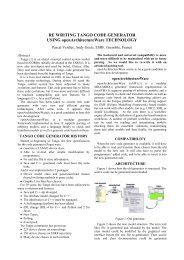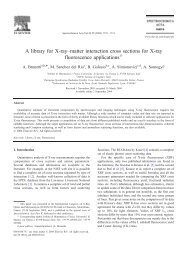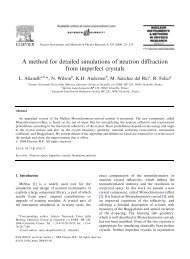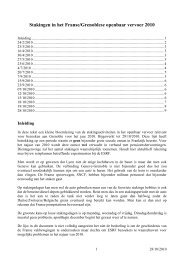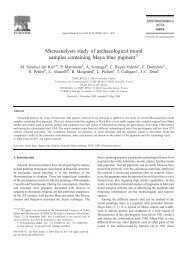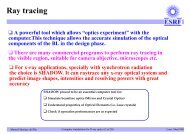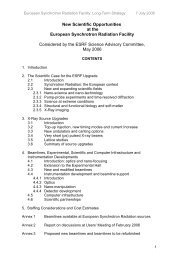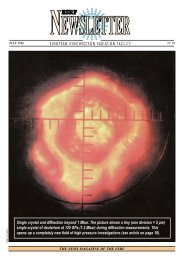Report on future detector requirements at ESRF
Report on future detector requirements at ESRF
Report on future detector requirements at ESRF
You also want an ePaper? Increase the reach of your titles
YUMPU automatically turns print PDFs into web optimized ePapers that Google loves.
Flux <strong>on</strong> <strong>detector</strong>:<br />
The flux <strong>on</strong> the <strong>detector</strong> is expected to be between 10 8 and 10 10 phot<strong>on</strong>s/s/mm 2 , depending<br />
<strong>on</strong> the energy. These values are smaller than the flux for other imaging beamlines because of<br />
two reas<strong>on</strong>s: ID17 uses <strong>on</strong>ly <strong>on</strong>e wiggler and the phot<strong>on</strong>s are spread over a larger beam.<br />
Particular oper<strong>at</strong>ing c<strong>on</strong>diti<strong>on</strong>s:<br />
Due to the use of high energy phot<strong>on</strong>s, radi<strong>at</strong>i<strong>on</strong> damage gener<strong>at</strong>es a very rapid blackening of<br />
the taper. Better radi<strong>at</strong>i<strong>on</strong> hardness would be appreci<strong>at</strong>ed.<br />
Required <strong>detector</strong><br />
Required <strong>detector</strong> is a large 2D rectangular <strong>detector</strong>, th<strong>at</strong> can be efficiently used <strong>at</strong> high<br />
energy.<br />
Existing <strong>detector</strong>s<br />
ID17 is currently using a FReLoN 2kx2k, with fibre optic taper and scintill<strong>at</strong>or.<br />
For the applic<strong>at</strong>i<strong>on</strong>s requiring less sp<strong>at</strong>ial resoluti<strong>on</strong> but more efficiency and speed, a Ge<br />
2-strip <strong>detector</strong>, with 350 µm pitch and 10 mm width, is used.<br />
Short term possibilities<br />
Structured CsI scintill<strong>at</strong>ors will be tested. The use of a FReLoN 4M instead of current<br />
FReLoN 2k will improve both dynamic range (by a factor 1.5) and quantum efficiency (65%<br />
efficiency <strong>at</strong> the Gadox emissi<strong>on</strong> wavelengths instead of 35%). Nevertheless, this will not<br />
directly permit to reduce the dose <strong>on</strong> the sample because in the case of taper coupling, where<br />
the light collecti<strong>on</strong> yield is high, the signal to noise r<strong>at</strong>io depends much more <strong>on</strong> the<br />
absorpti<strong>on</strong> coefficient of the scintill<strong>at</strong>or than <strong>on</strong> the quantum efficiency (see DQE formula in<br />
[Koch et al., 1998]). This means th<strong>at</strong> even if the total yield of the <strong>detector</strong> is increased, the<br />
SNR will not be proporti<strong>on</strong>ally improved.<br />
Main required improvements<br />
The main expected improvements c<strong>on</strong>cern the efficiency and the field of view <strong>at</strong> c<strong>on</strong>stant or<br />
better sp<strong>at</strong>ial resoluti<strong>on</strong>. Radi<strong>at</strong>i<strong>on</strong> hardness of optical couplings has to be improved.<br />
Other types of <strong>detector</strong>s<br />
MIA requires other 2D <strong>detector</strong>s (see pages 30, 32 and 39).<br />
38



